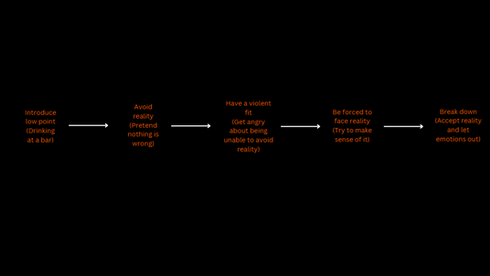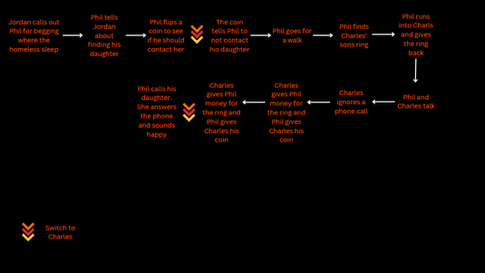The Extraordinary Denial
Of Mr. Charles Bannister

ROLE
Writer, Programmer
GAME ENGINE
Twine
TEAM
Solo project
TIME FRAME
2 Weeks
DESCRIPTION
An interactive short story where the reader embodies an intrusive thought, guiding two characters through a night of difficult revelations and inner conflicts.
CONCEPT

Writing about grief
I wanted to challenge myself by writing an authentic journey to acceptance of a 40 year old man's traumatic loss of his son. An experience I personally never have faced but I hoped to better understand.
[Credit for the second image goes to Disco Elysium. It was used in this context for inspiration.]
Synopsis
Seeking solace at the bottom of a bottle at a local pub, Charles has decided to leave his wife after a tragic event tore his family apart. Having immersed himself in denial, Charles is eventually confronted by a neglected truth and has to come to terms with what it means to accept it.
After the tragic passing of his beloved wife, Phil abandoned his daughter and became a homeless man, but for the first time in twenty years, he is presented with the opportunity to reconcile with her. With nothing to his name and a bad record as a father, Phil struggles with the morals of reuniting a broken family.
DEVELOPMENT
6 steps of grief
After choosing the story’s theme, I researched the stages of grief and used them to structure Charles’ journey, outlining behaviors that could help communicate each stage to the player.


Common grieving behaviour
To communicate these behaviors through action, I listed habits Charles could repeat throughout the game so that I could challenge those habits through different events gradually moving Charles towards acceptance.

I followed a simliar process for Phil, who unfortunately has a shorter story due to time constraints.
To make the story more engaging, I added optional choices early in the game that let players glimpse Charles' destructive routines before returning them to the bar. These branches contained no essential information and were meant to enhance immersion without affecting the main narrative.


To increase player involvement, I cast them as an intrusive thought inside each character’s head, allowing them to interact by offering guidance. Characters may either comply or resist which can result in a conflict between the player and the characters.
These conflicts result in challenges requiring the player to complete small tasks to progress. One example being when Charles is experiencing a meltdown, the player has to scroll through an unconventionally long Twine node to get to the next page.
CONTRIBUTIONS
Narrative
-
Game Writing
-
Wrote the narrative script
-
Divided the script into Twine nodes
-
Wrote the dialogue.
-
Implementation
-
Coding
-
Programmed the node transitions and other visual details.
-
Connected different node paths.
-
REFLECTION
I’m generally happy with how Charles’ journey turned out. While I would have liked to make gameplay more engaging, the process was very educational for me, as I learned more about Twine and about writing a character so different from myself.
My biggest regret is that due to time constraints, Phil's story remained one of a supporting character when I initially intended to give him a larger role.
If I had more time on this project I would add more interactive elements, sound effects and more imagery to the experience.



